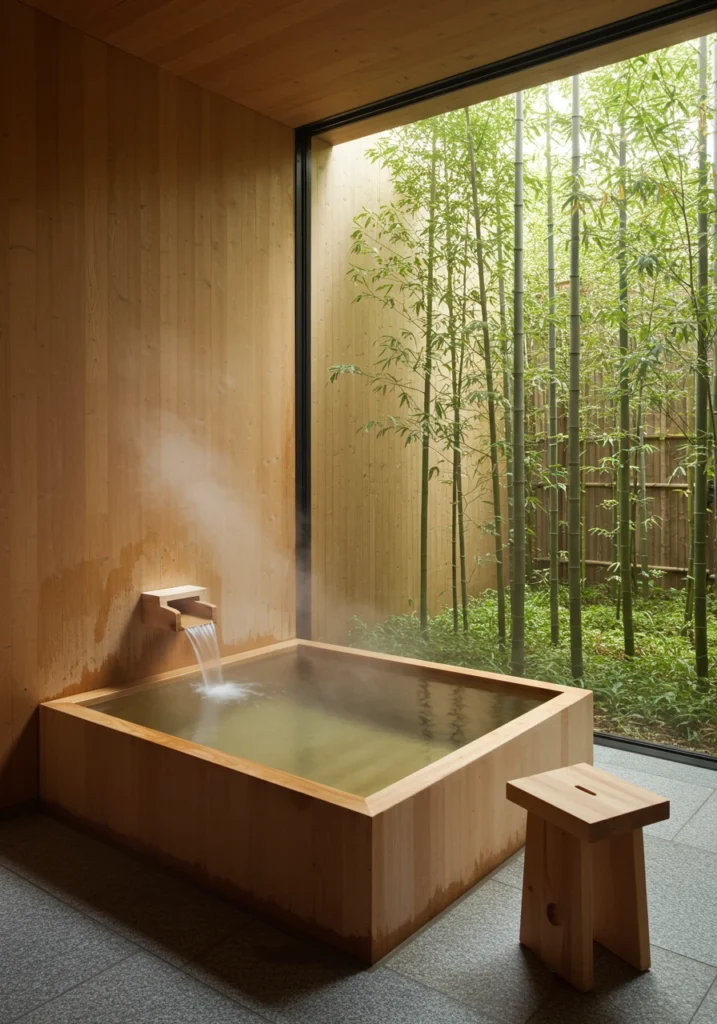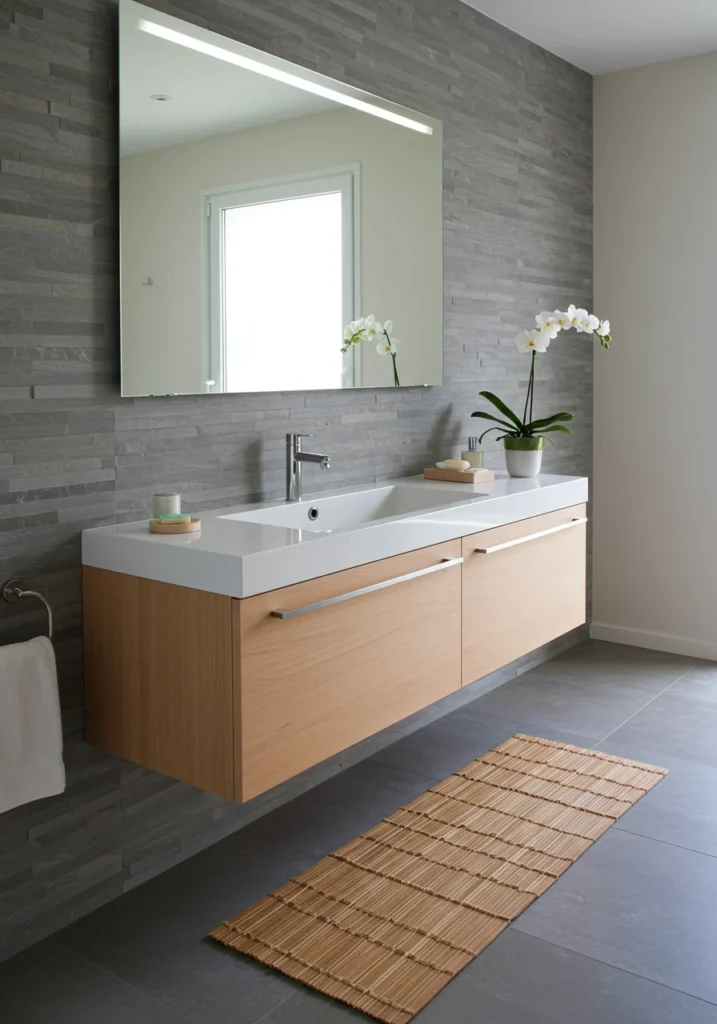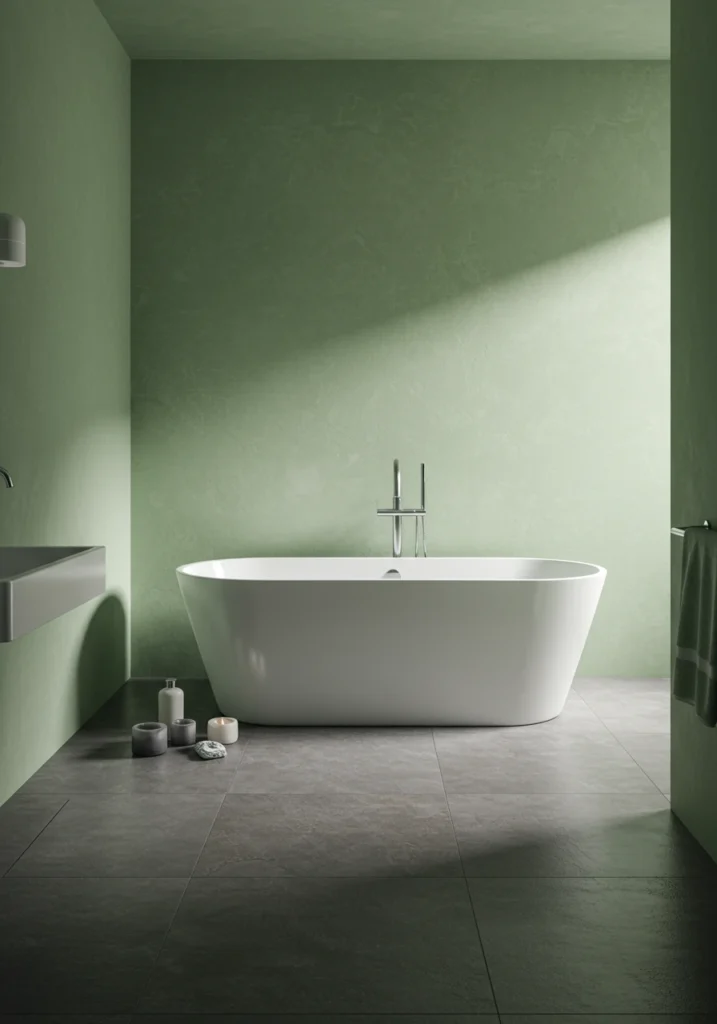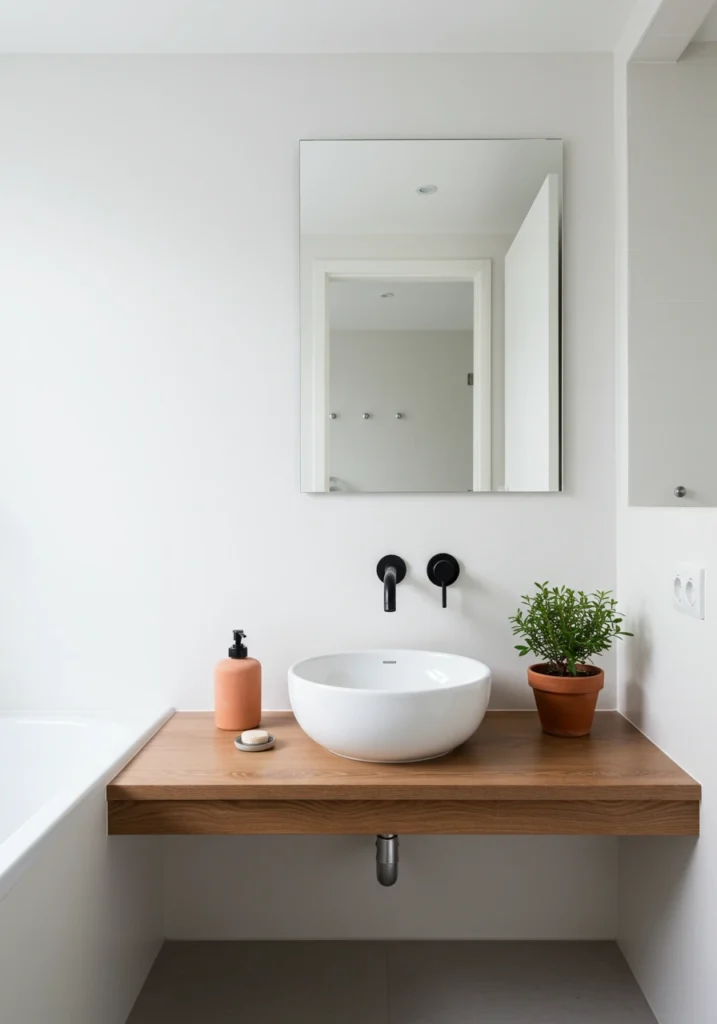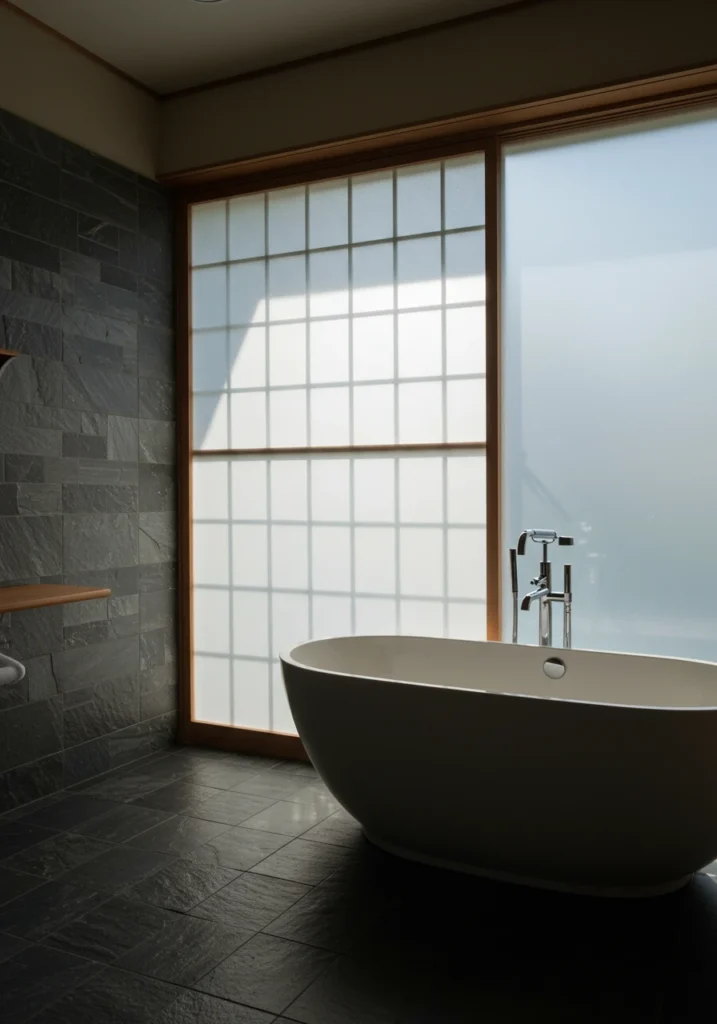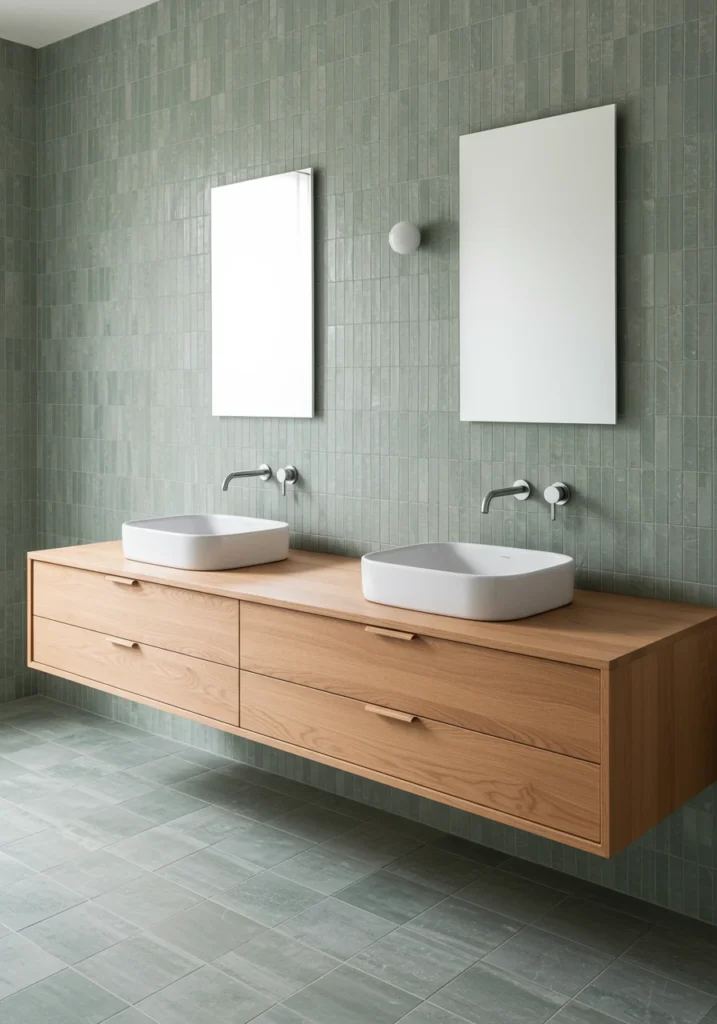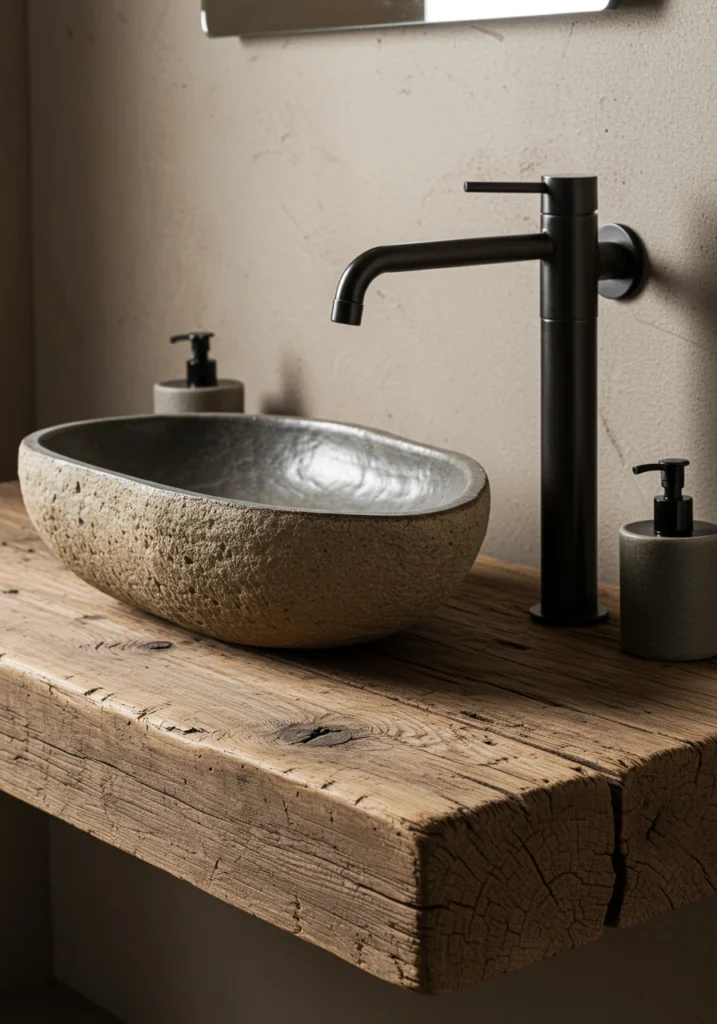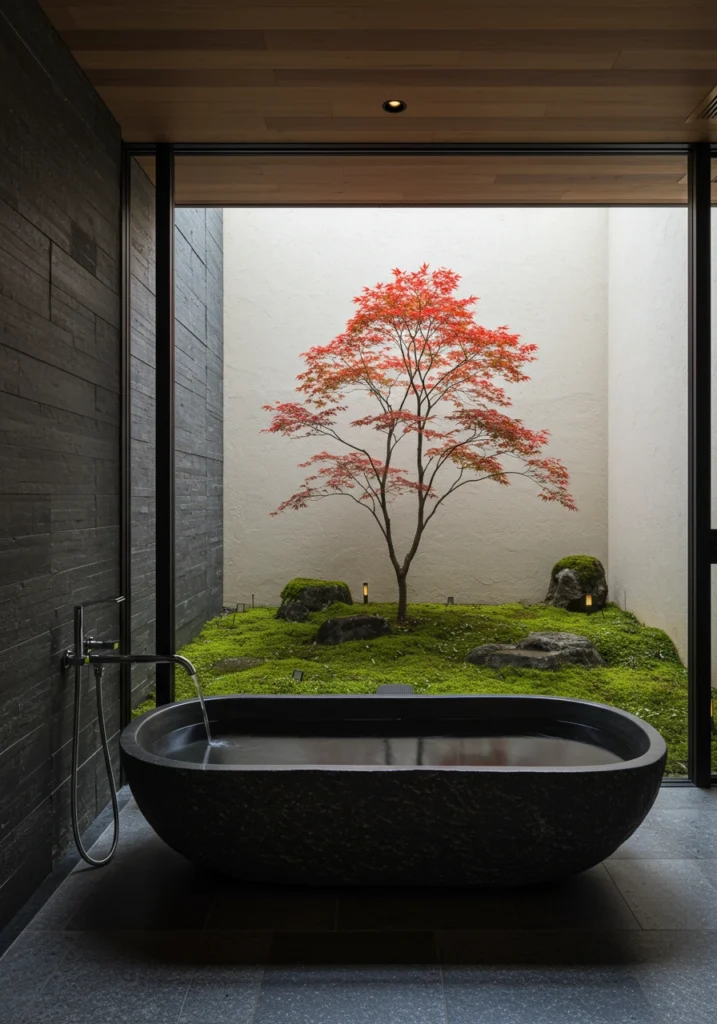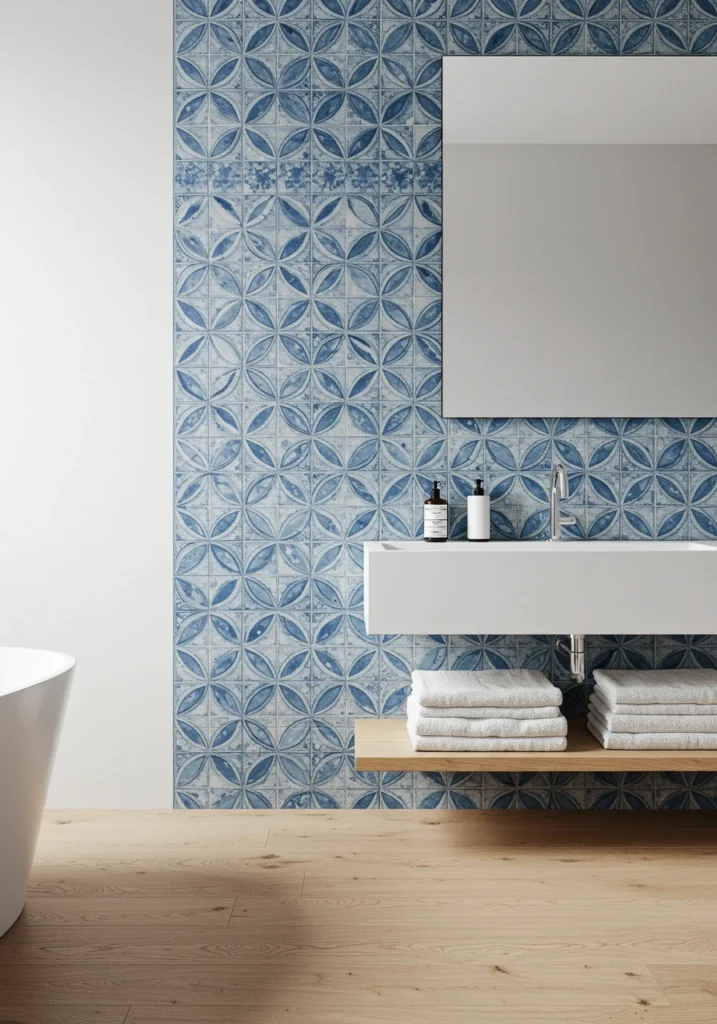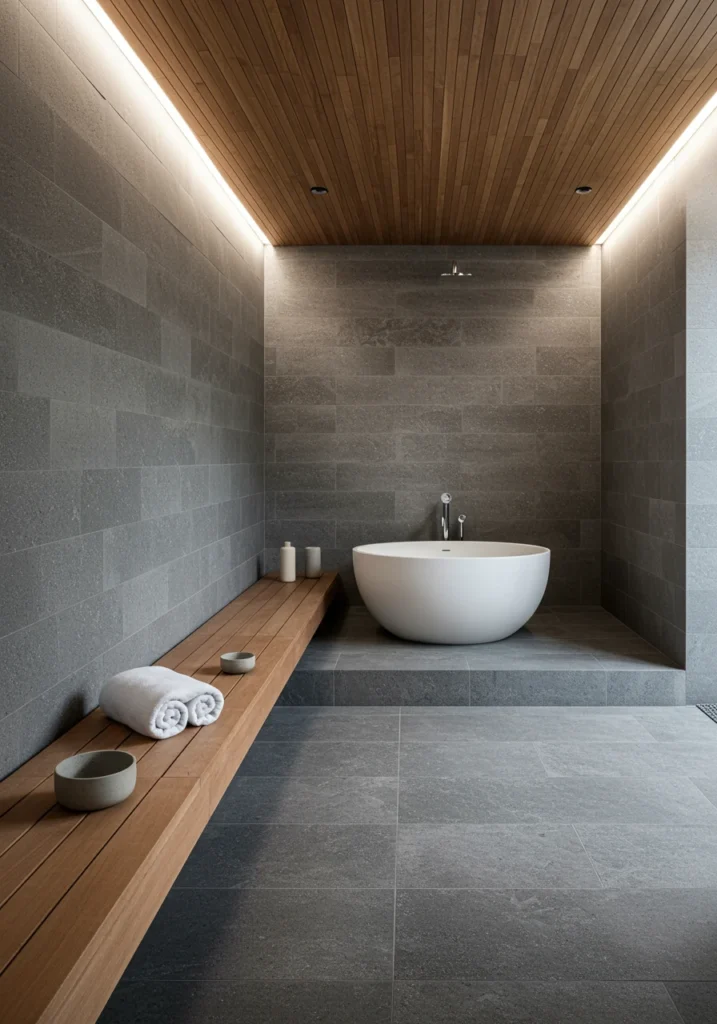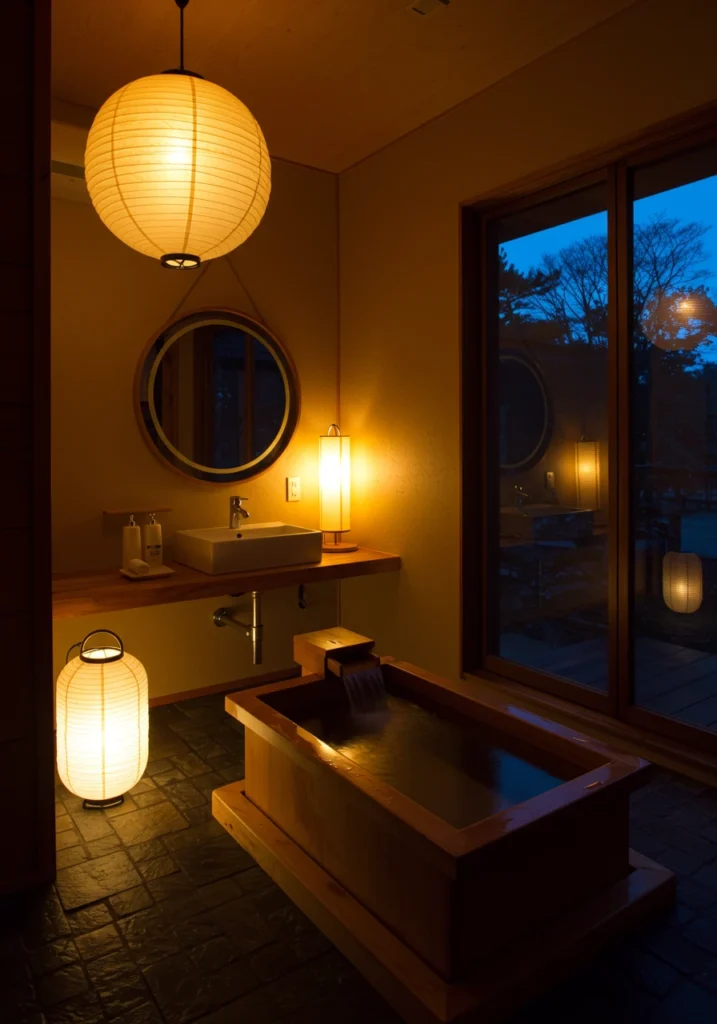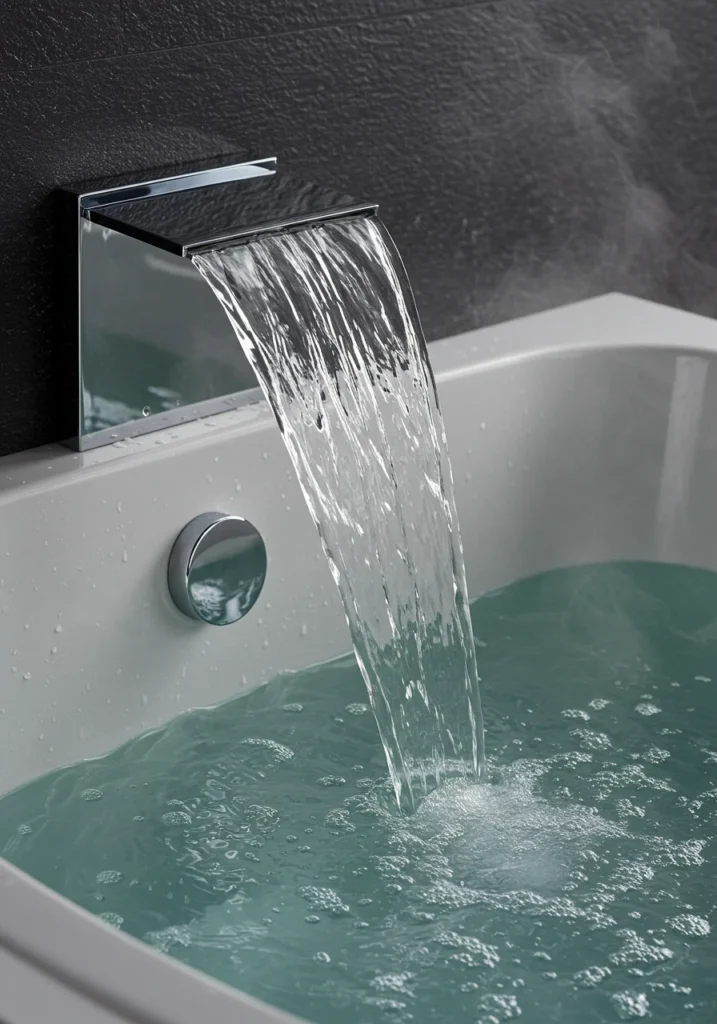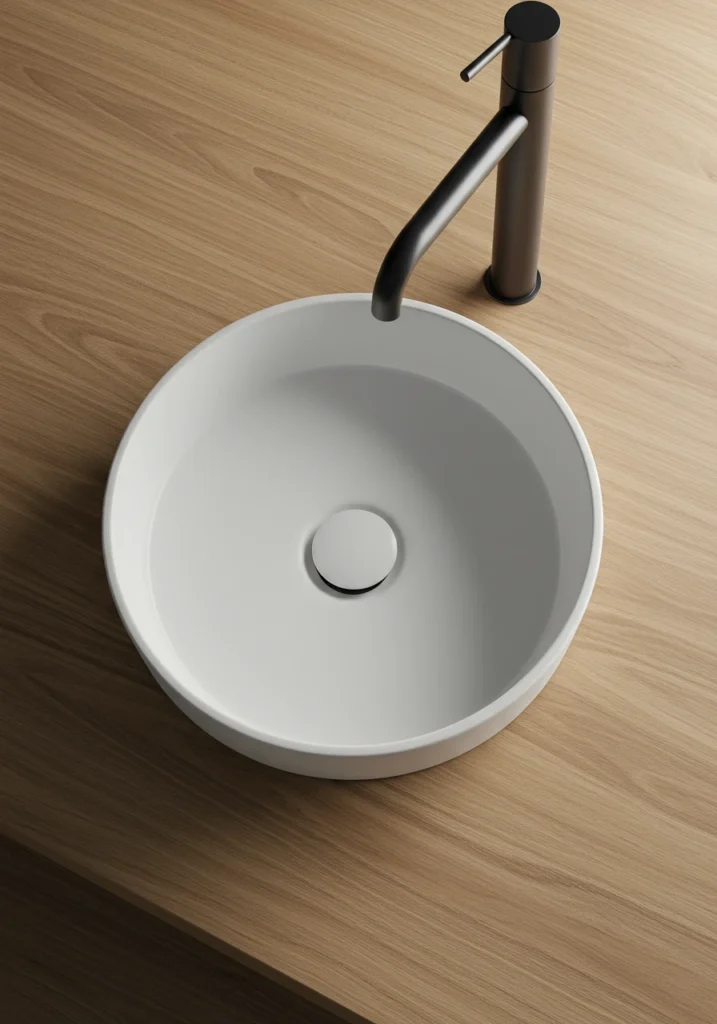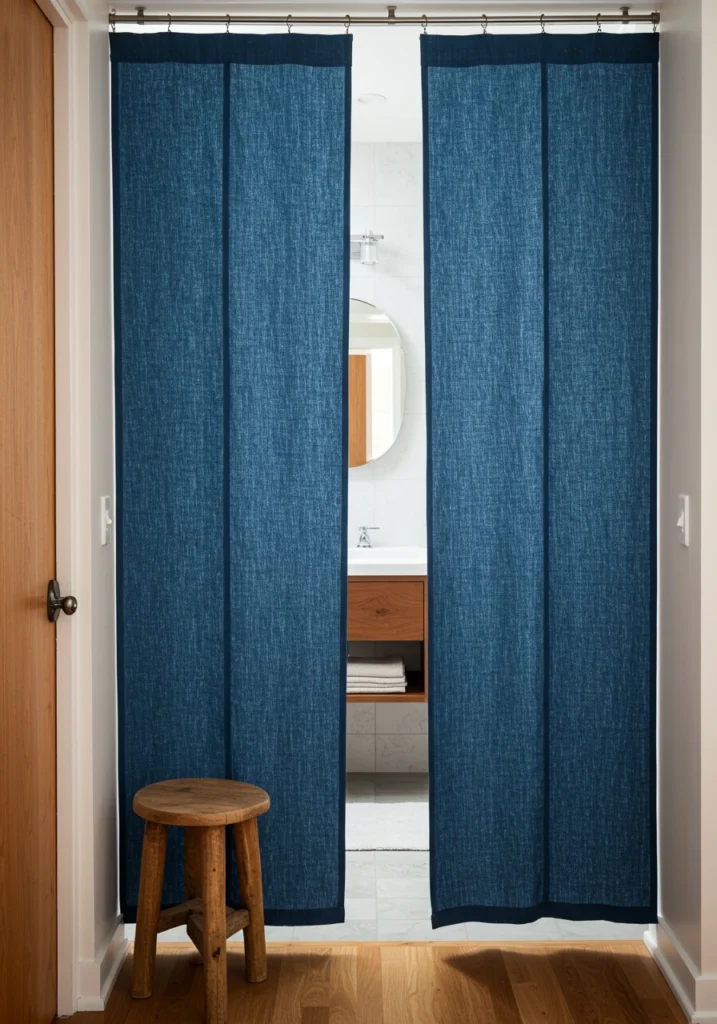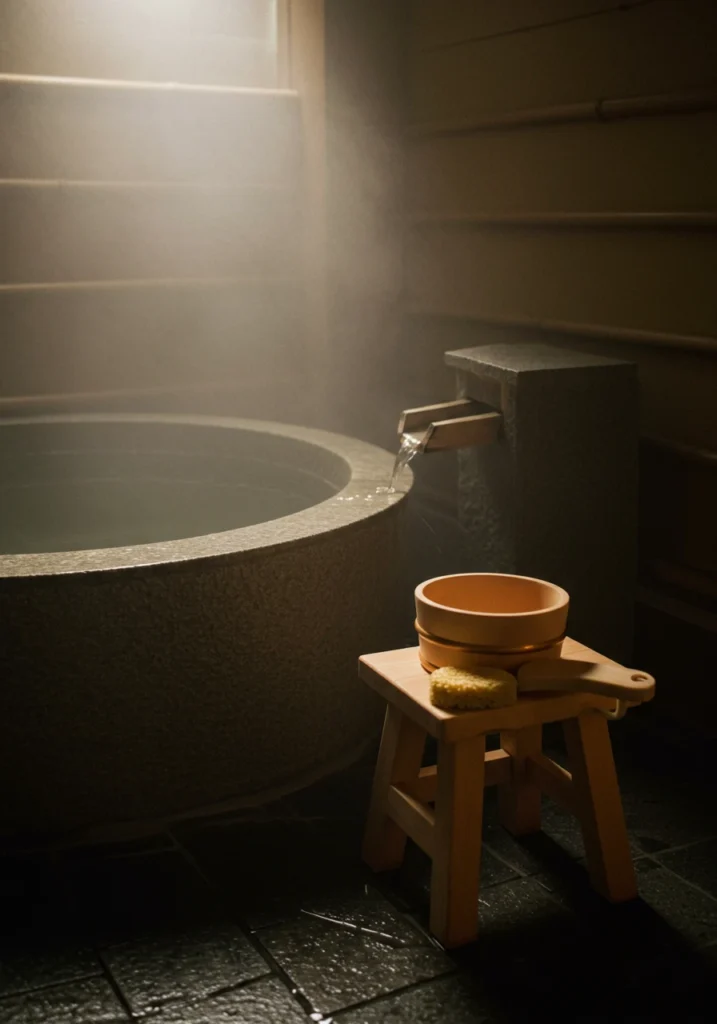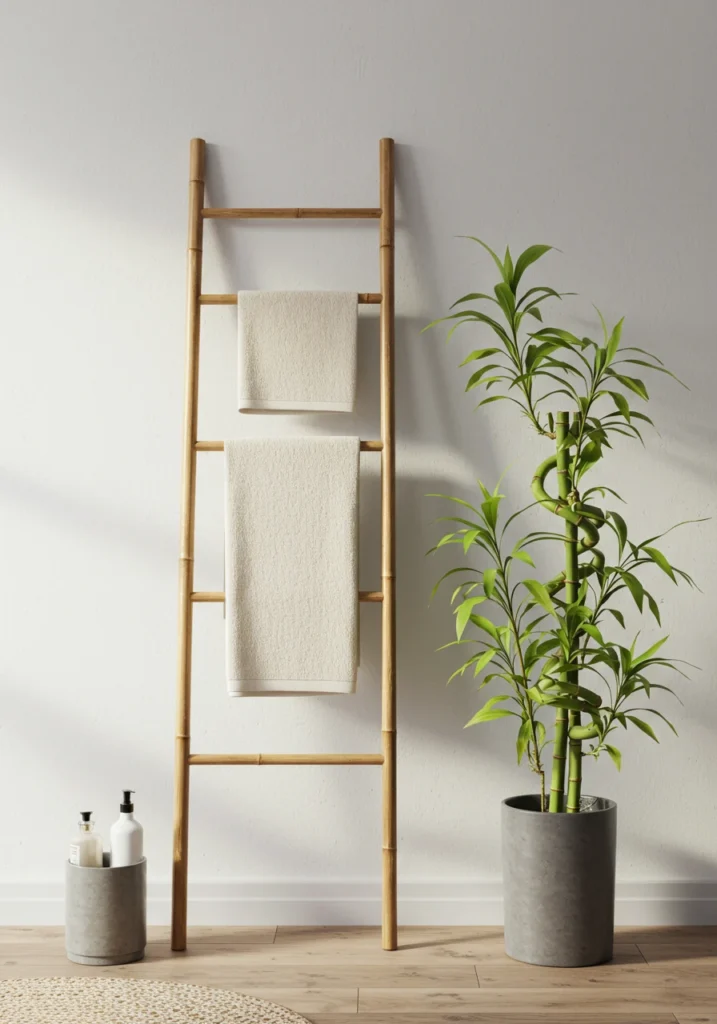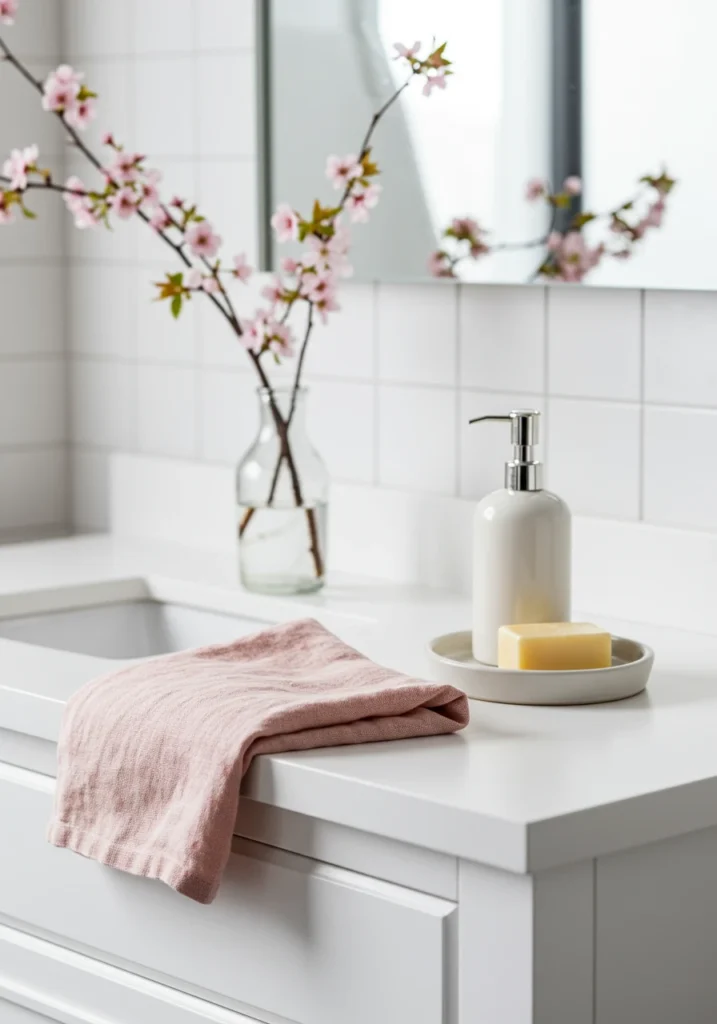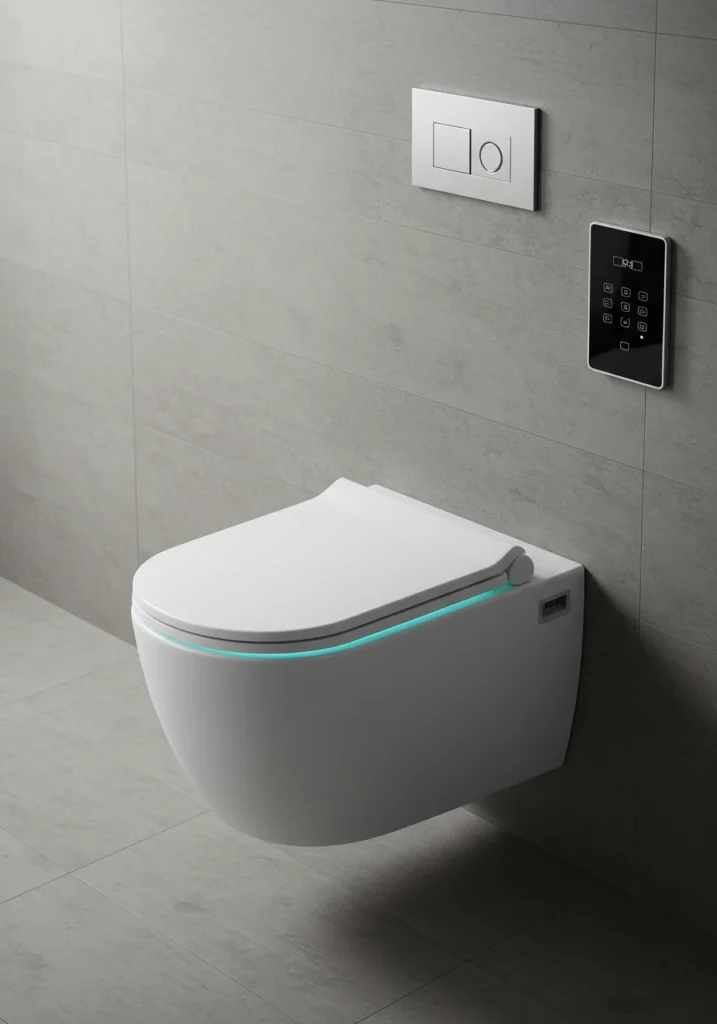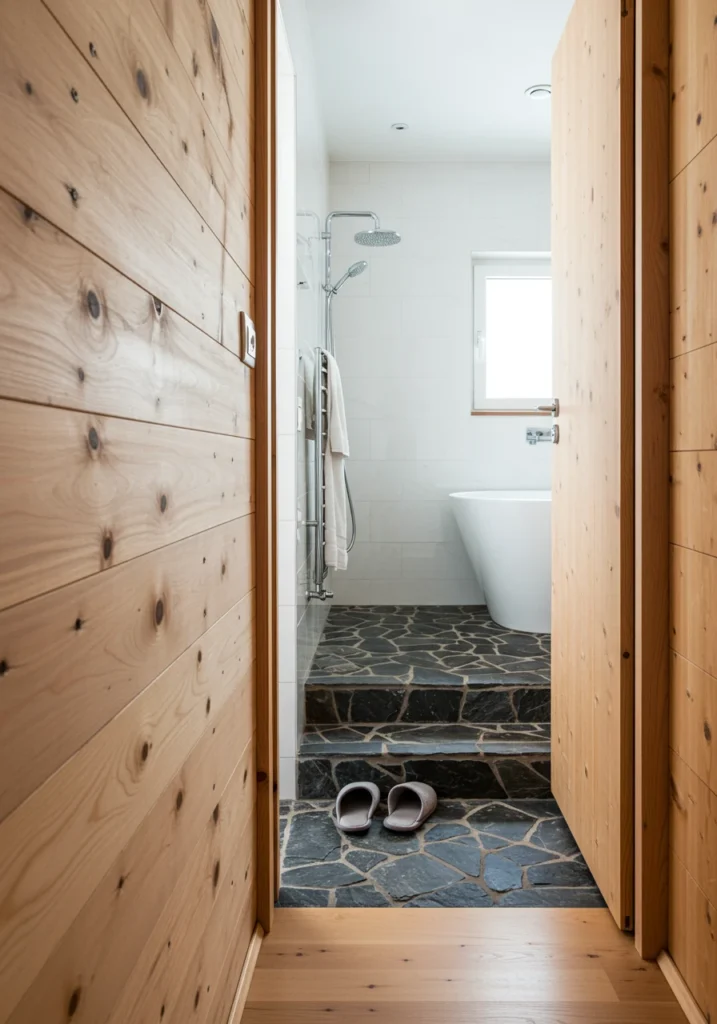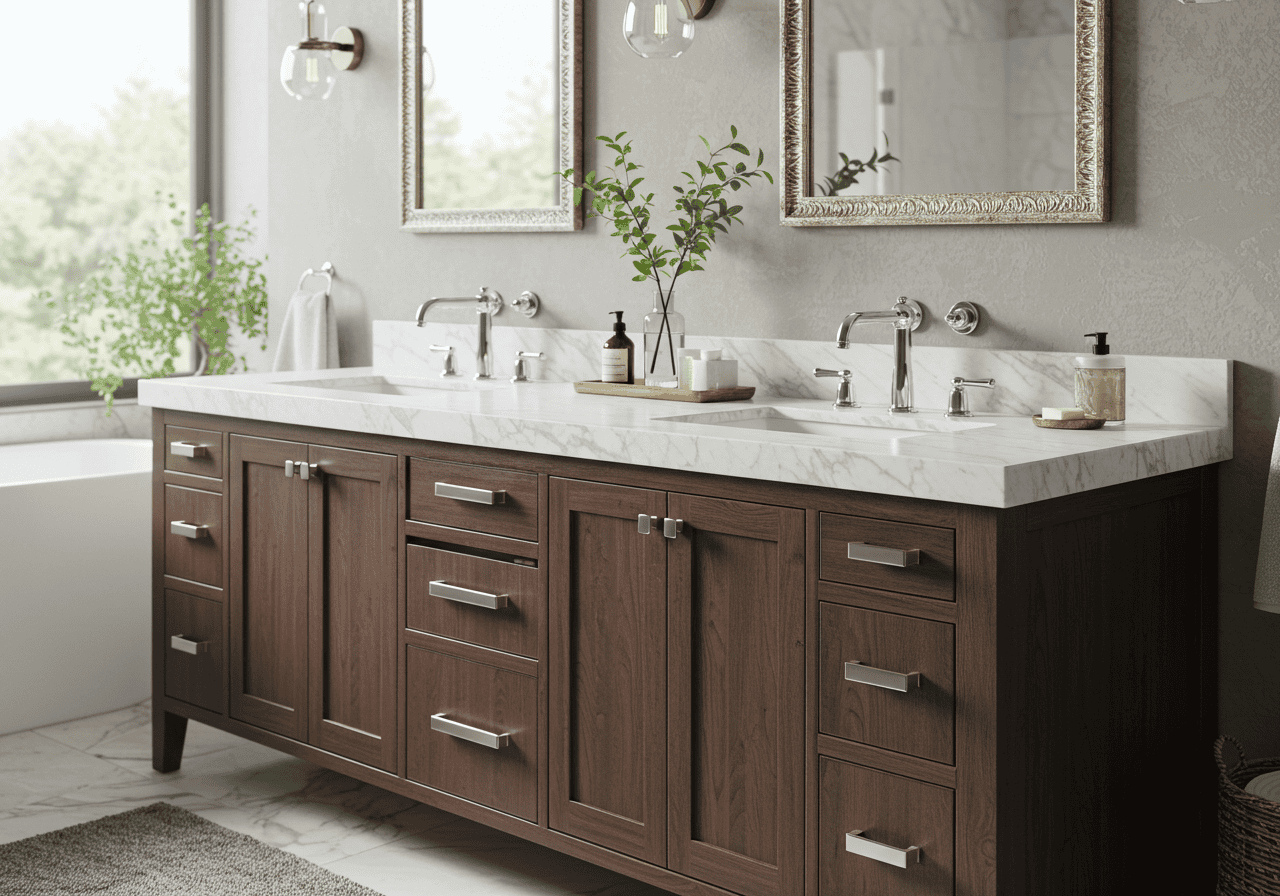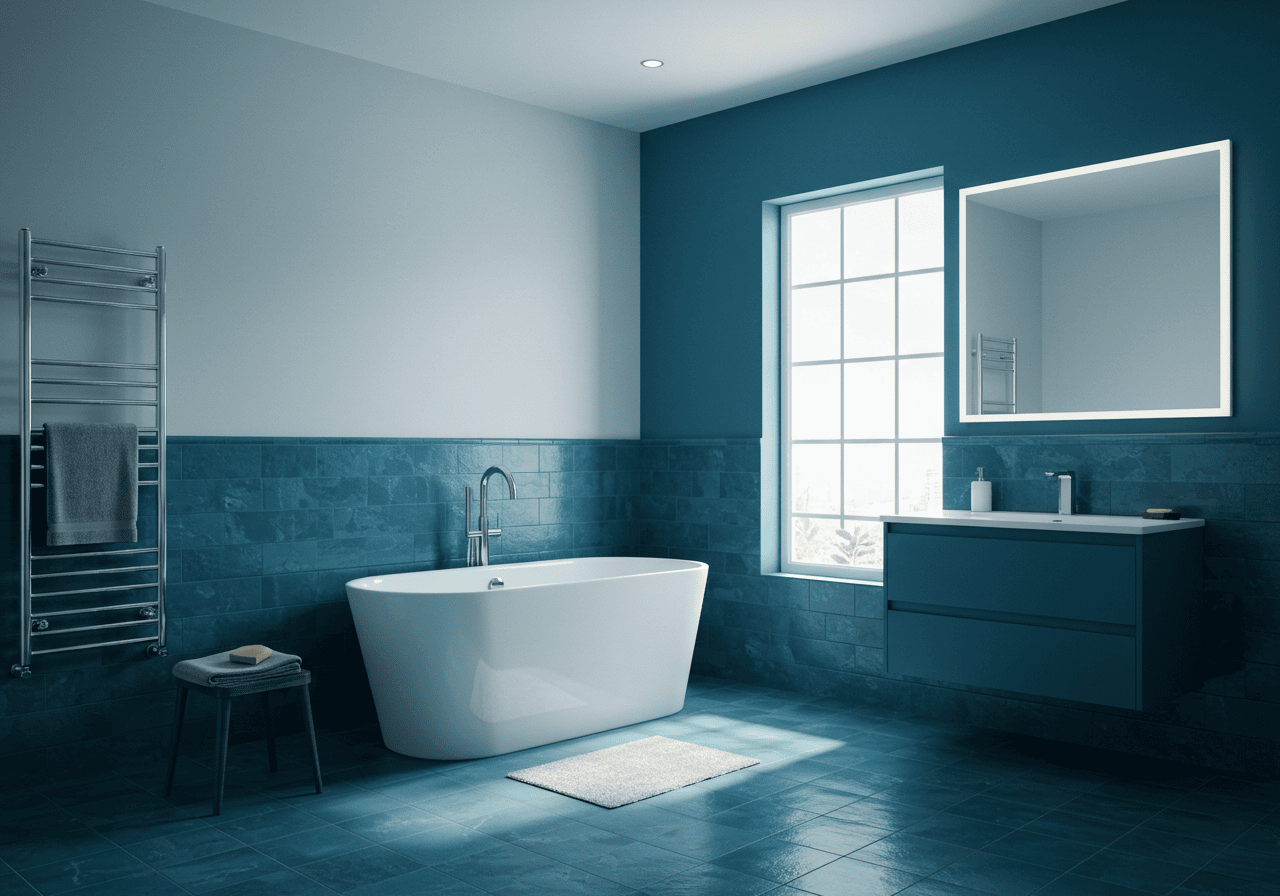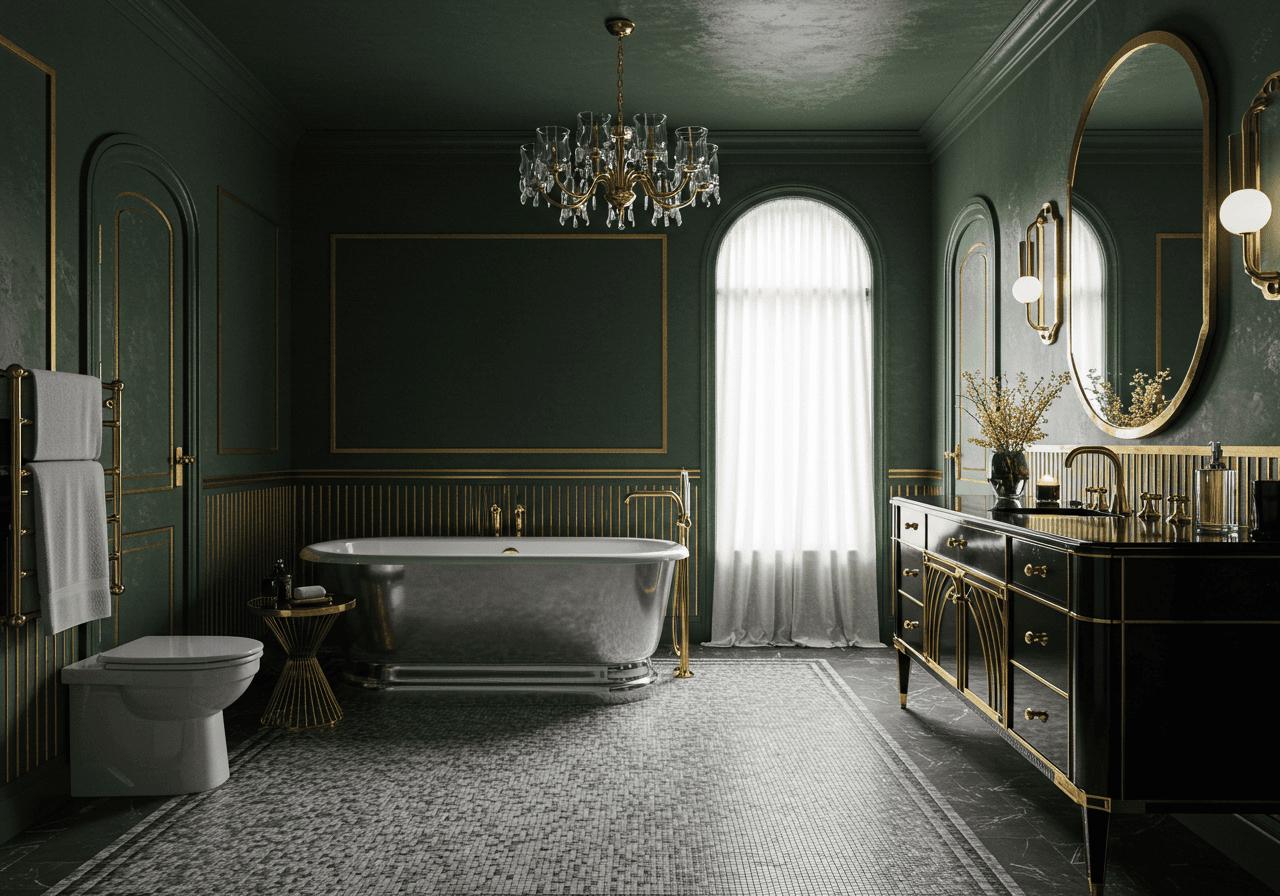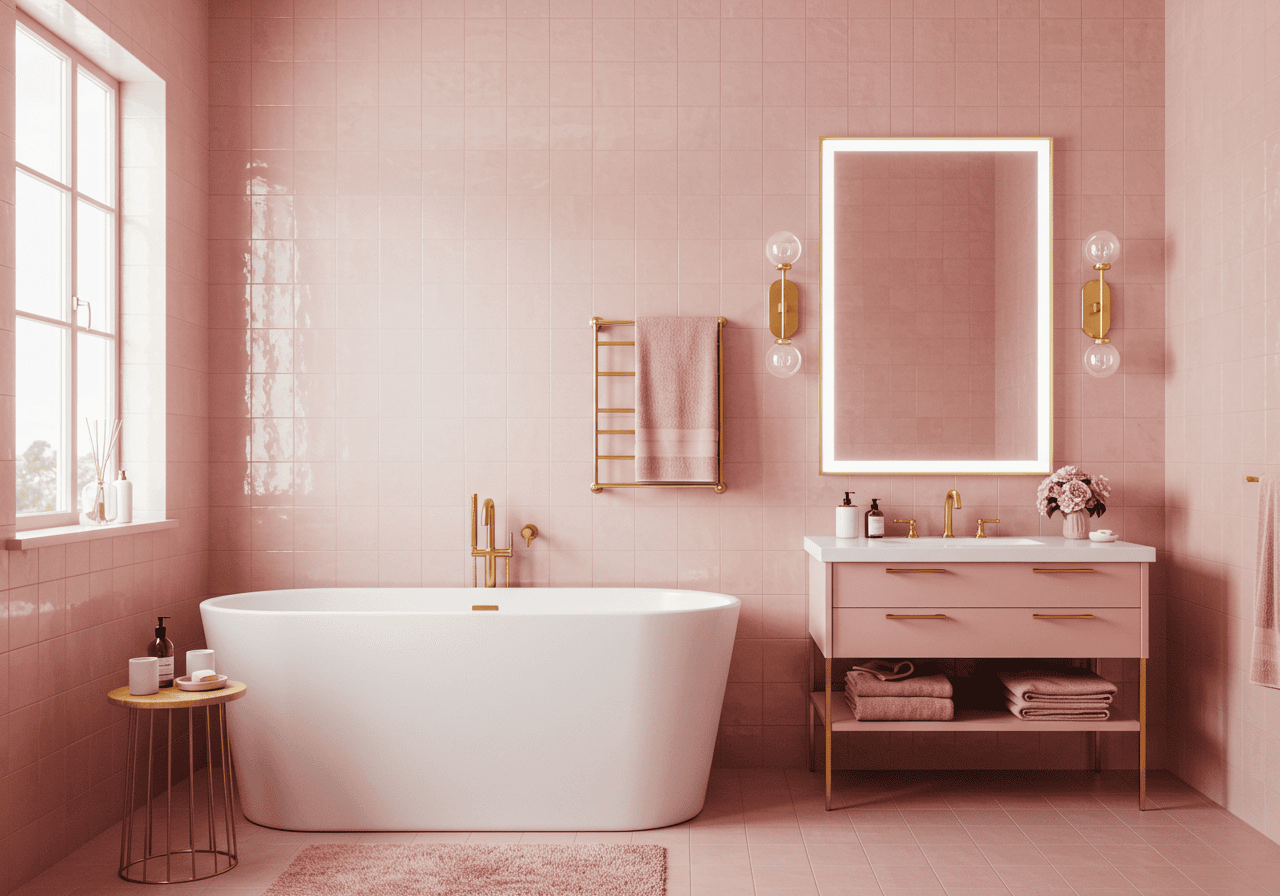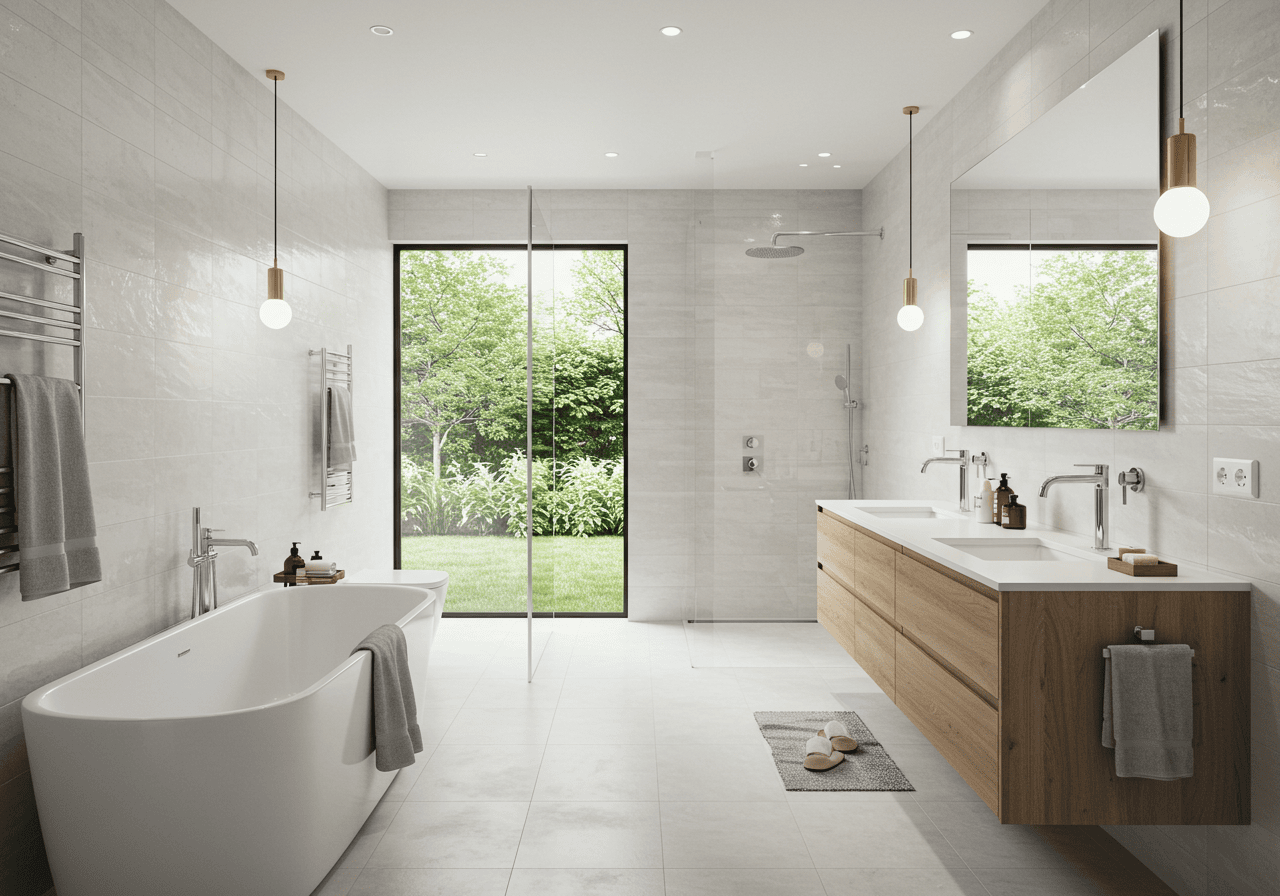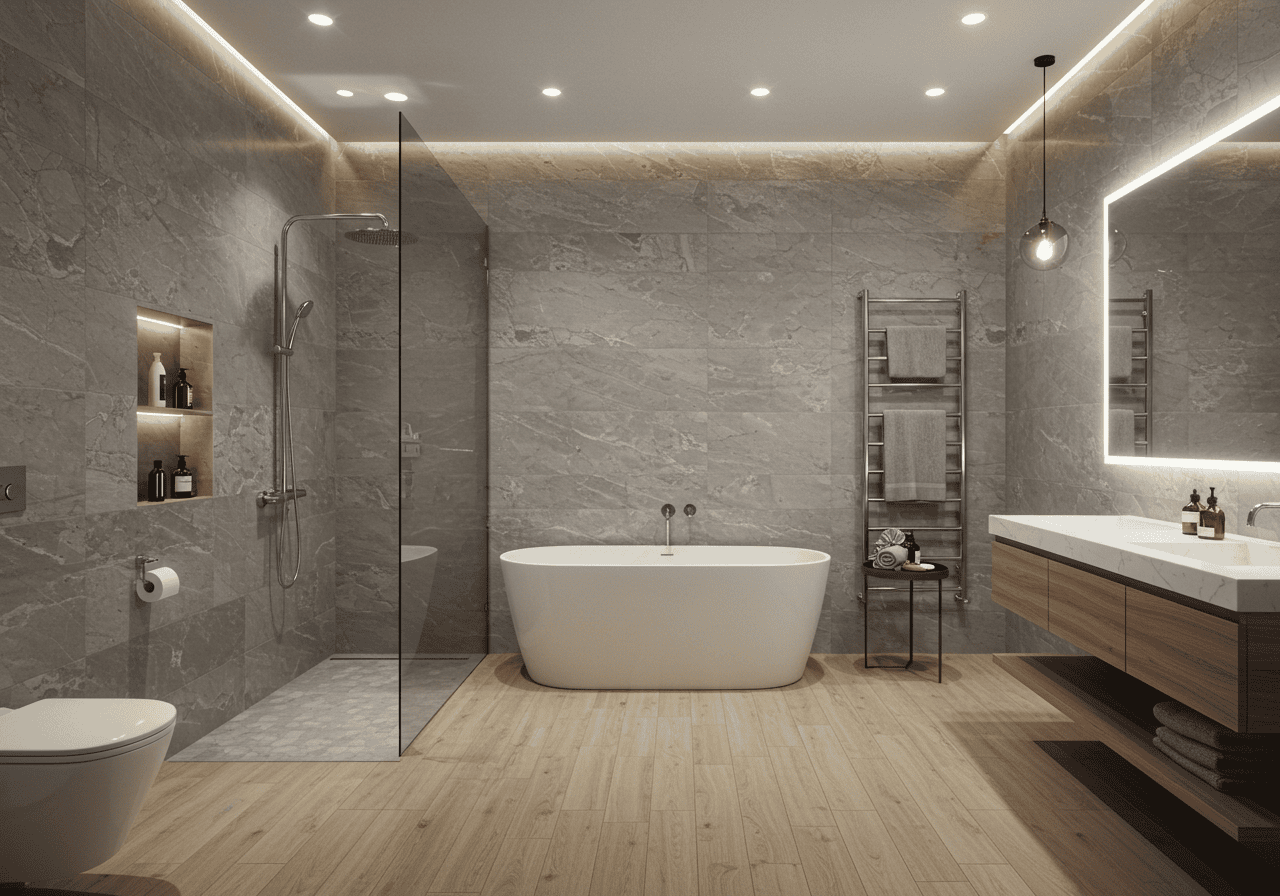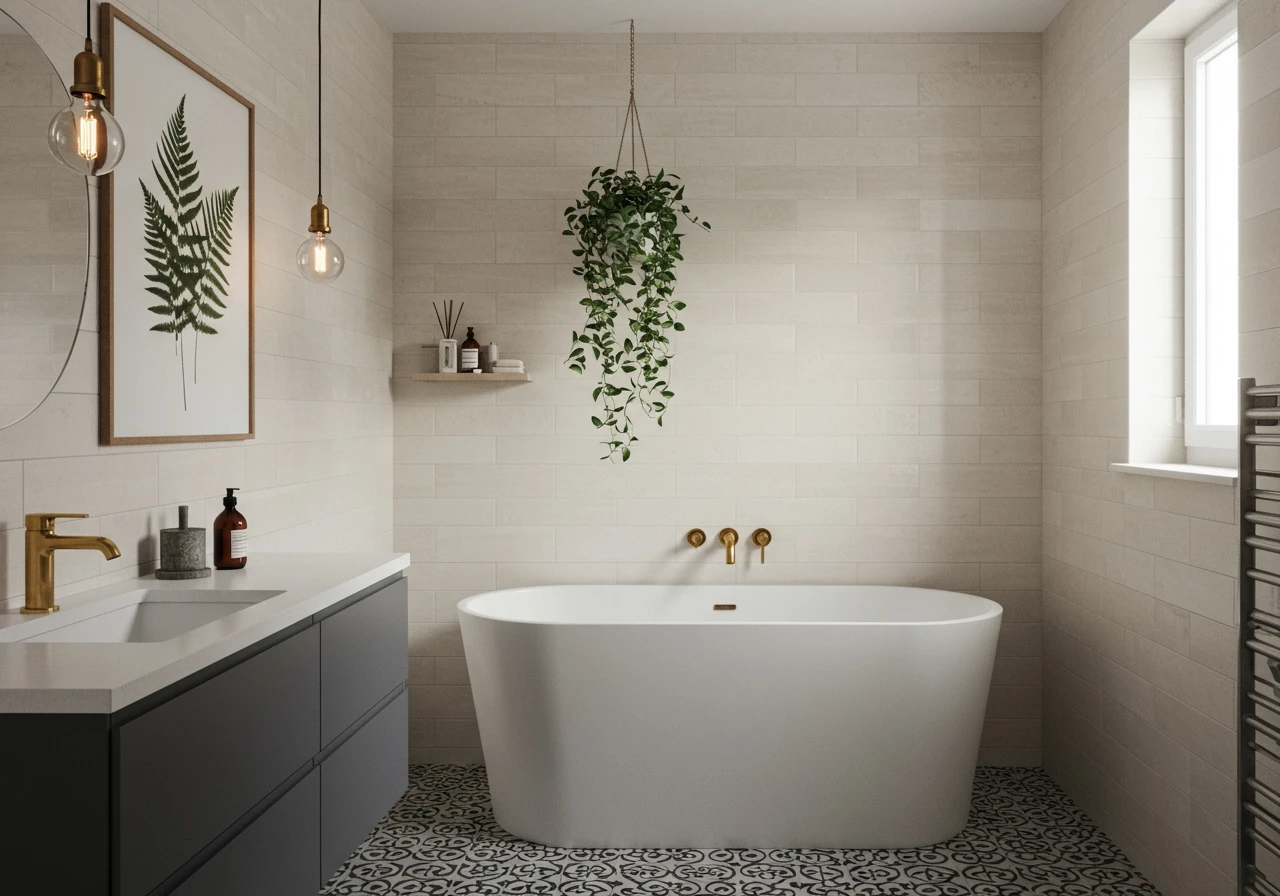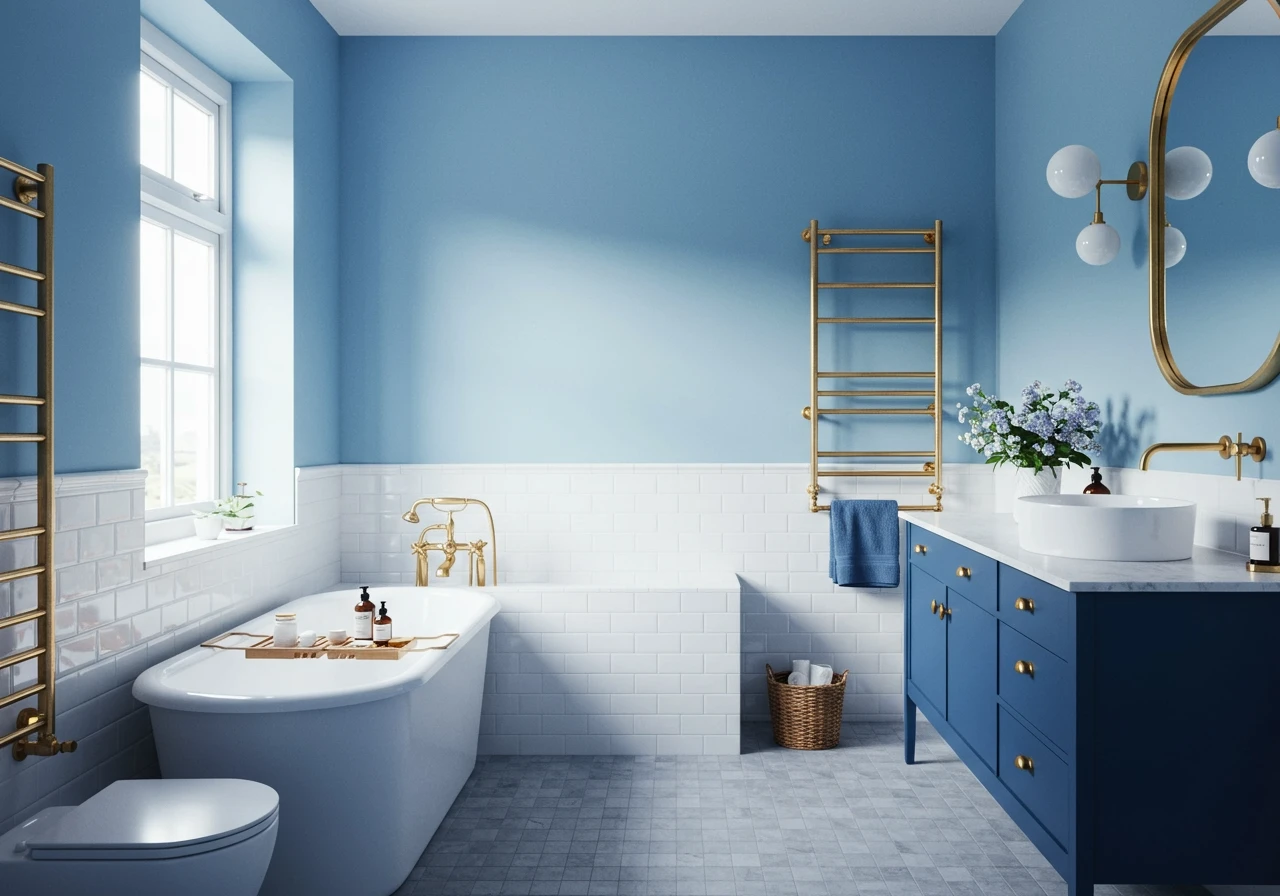Tired of bathrooms that are purely functional and lack soul? Imagine stepping into a space that feels less like a room and more like a retreat—a personal sanctuary where the stress of the day simply melts away. This is the essence of a Japanese bathroom.
Rooted in centuries of tradition centered on relaxation, mindfulness, and a deep connection to nature, Japanese bathroom design is a masterclass in creating tranquility. It’s not about flashy decor; it’s about thoughtful simplicity, natural materials, and the calming ritual of bathing. Forget the rushed morning shower—we’re here to embrace the art of the serene escape.
Ready to transform your bathroom into a Zen-inspired oasis? Here are our favorite Japanese bathroom ideas to inspire your own peaceful haven.
1. Embrace the Ofuro: The Art of the Soaking Tub
At the very heart of the Japanese bathroom is the ofuro, a deep soaking tub that is fundamentally different from its Western counterpart. Its purpose isn’t for washing—that’s done beforehand—but for quiet contemplation and deep relaxation.
Ofuro tubs are traditionally crafted from aromatic woods like Hinoki cypress, which releases a soothing, lemony scent when filled with hot water. They are characteristically shorter but much deeper than standard tubs, allowing you to submerge yourself up to your shoulders in a comforting embrace.
- Expert Tip: To create an authentic experience, place a small wooden stool and bucket next to the tub or in a separate shower area for pre-soaking cleansing.
- Modern Twist: Don’t have space for a traditional wooden tub? A modern, deep-soaking acrylic or stone composite tub can evoke the same feeling. Focus on depth over length to achieve that perfect, immersive soak that defines a luxury bathroom design.
2. Weave in a Symphony of Natural Materials
Japanese design celebrates nature in its purest form. Bringing organic textures and materials into your bathroom is essential for creating a grounding and harmonious atmosphere. Move away from cold, sterile surfaces and welcome the warmth of the natural world.
The goal is to create a sensory experience—the feel of smooth river stones underfoot, the subtle scent of cedar, the visual calm of bamboo.
- Wood: Use woods like bamboo, light maple, cedar, and hinoki for vanities, wall paneling, bath mats, and accessories. Their natural warmth is instantly calming.
- Stone: Incorporate slate, river rocks, or granite for flooring and accent walls. Polished pebbles in the shower floor can create a wonderful foot-massage effect. Explore different bathroom tile design ideas to find the perfect natural stone look.
- Plants: A touch of green is non-negotiable. A simple bamboo stalk in a vase, a delicate orchid, or a lush fern will purify the air and add a vibrant touch of life.
3. Master the Wet and Dry Zone Separation
A key functional principle of Japanese bathrooms is the separation of spaces. The room is typically divided into a “wet zone” and a “dry zone.” The wet area, containing the shower and the ofuro, is fully waterproofed—a true wet room where you don’t have to worry about splashing. The dry area houses the vanity and toilet.
This thoughtful layout enhances both practicality and the sense of ritual. The transition from the functional dry space to the relaxing wet space is a mental cue to unwind.
- How to Achieve It: A seamless glass screen is a popular modern solution to contain water without visually cluttering the space.
- Space-Saving Solution: Even in a smaller room, you can create this concept. A well-designed layout can incorporate one of these small bathroom walk in shower ideas to create a dedicated, waterproof wet zone next to the tub.
4. Let Nature In with Earthy Color Palettes
Forget loud, jarring colors. The Japanese aesthetic is all about soothing, earthy tones that mimic the natural landscape. Think of a misty forest, a serene Zen garden, or a quiet pebble beach. This restrained color palette is the foundation for a truly peaceful environment.
Build your design around these core colors:
- Neutrals: Soft whites, warm beiges, and gentle creams create a bright and airy base.
- Earthy Tones: Ground the space with shades of stone grey, soft brown, and deep charcoal.
- Natural Hues: Use muted greens and tranquil blues as subtle accents. A green bathroom inspired by moss and bamboo can feel incredibly restorative and on-theme.
Bold accents should be used sparingly. A touch of black in the tapware or window frames can add a contemporary, graphic element that provides definition without overwhelming the senses.
5. Embrace Minimalism: The Power of “Ma” (Negative Space)
In Japanese aesthetics, what you don’t see is just as important as what you do. This is the concept of Ma, or negative space. It’s the intentional emptiness that allows key elements to breathe and be appreciated. A cluttered bathroom leads to a cluttered mind, and the goal here is the exact opposite.
This “less is more” philosophy is the secret to a truly serene space. It’s not about stripping your bathroom of personality; it’s about curating it with intention.
- Declutter Ruthlessly: Store toiletries, cleaning supplies, and extra towels out of sight in sleek, built-in cabinets or simple woven baskets.
- Curate Your Countertops: Keep surfaces clear, displaying only a few beautiful, functional items—a ceramic soap dispenser, a small plant, or a scented candle.
- Focus on Form: Each item left in view, from the faucet to the towel hook, should be chosen for its beautiful, simple form. This approach is central to many contemporary bathroom ideas.
6. Incorporate Shoji Screens for Diffused Light and Privacy
One of the most iconic elements of Japanese interiors is the Shoji screen. Made from translucent washi paper set in a wooden lattice frame, these screens are masters of light manipulation. They provide essential privacy while allowing a soft, ethereal glow to filter through, eliminating harsh shadows and creating a calming ambiance.
While traditional paper screens may not be ideal for the most humid parts of a bathroom, you can capture their essence with modern, moisture-resistant materials.
- Modern Alternatives: Use frosted, textured, or laminated glass panels in a wooden or black metal frame for windows, shower doors, or room dividers.
- Layered Lighting: Combine the diffused natural light from a Shoji-style window with soft, warm artificial lighting. Think backlit mirrors or simple, paper-lantern-style sconces. The aesthetic pairs beautifully with the clean lines often found in a mid-century modern bathroom.
7. Elevate Your Space with a Floating Vanity
To enhance the feeling of spaciousness and maintain that minimalist ethos, a floating vanity is a perfect choice. By mounting the cabinet to the wall, you leave the floor underneath visible, which instantly makes the room feel larger, airier, and much easier to clean.
The clean, horizontal lines of a floating vanity complement the uncluttered nature of Japanese design. Choose one made from a beautiful, natural wood to add warmth and texture to the space.
- Material Matters: Look for vanities in light woods like bamboo or maple, or richer tones like teak or walnut for a touch of contrast.
- Function and Form: Opt for models with handleless, push-to-open drawers to maintain a seamless and uninterrupted facade. Even a larger double sink bathroom vanity can feel weightless and elegant when designed in this style.
8. Embrace Wabi-Sabi: The Beauty of Imperfection
In our quest for perfection, we often miss the beauty in the authentic and the incomplete. This is where the Japanese philosophy of wabi-sabi comes in—a worldview centered on the acceptance of transience and imperfection. In design, this translates to celebrating natural materials that age gracefully, handcrafted items with unique flaws, and an overall sense of soulful, lived-in character.
A wabi-sabi bathroom feels deeply personal and serene. It’s a space that tells a story, rejecting the coldness of mass-produced perfection for the warmth of the perfectly imperfect.
- Incorporate Handcrafted Elements: Choose a hand-thrown ceramic vessel sink or artisan-made tiles where no two are exactly alike.
- Let Materials Age: Use unlacquered brass fixtures that will develop a beautiful patina over time, or a reclaimed wood stool that shows its history. This appreciation for aged items creates a bridge to the charm found in a vintage bathroom.
- Textured Walls: Consider limewash or tadelakt plaster for the walls. Their subtle, cloudy variations in texture and color add incredible depth and a soft, organic feel.
9. Frame Nature with “Borrowed Scenery” (Shakkei)
Why limit nature to a small potted plant? The Japanese design principle of shakkei, or “borrowed scenery,” is the art of integrating the surrounding landscape into your interior view. This means strategically placing windows and openings to frame a beautiful scene—be it a garden, a tree, or even just the sky—making it an integral part of your bathroom’s design.
This creates a dynamic, living artwork that changes with the seasons and the time of day, reinforcing the connection between your personal sanctuary and the natural world.
- The Picture Window: If privacy allows, a large, frameless window next to the bathtub can completely transform the space, dissolving the boundary between indoors and out.
- Clerestory Windows: High, horizontal windows can frame views of treetops and the sky while maintaining complete privacy.
- Create Your Own View: No garden? No problem. Even in an urban setting, you can create a small rock and bamboo garden in a lightwell or on a balcony right outside your bathroom window. It’s a key principle for elevating apartment bathroom decor ideas.
10. Add a Touch of Tranquil Indigo Blue
While the Japanese color palette is dominated by earthy neutrals, there is a deep reverence for one color in particular: indigo blue. Known as aizome, this rich, deep blue has been used in Japanese textiles and ceramics for centuries. It evokes a sense of calm, depth, and tranquility, much like the deep sea or a twilight sky.
Using indigo as a deliberate accent adds a layer of sophisticated color without disrupting the bathroom’s peaceful atmosphere.
- Tiled Accent Wall: A feature wall of indigo-dyed or Shibori-patterned tiles can create a stunning and artistic focal point.
- Textile Touches: The easiest way to introduce the color is through high-quality linen or cotton towels, a bath mat, or a simple noren curtain.
- Ceramic Details: A beautiful indigo-glazed soap dispenser, toothbrush holder, or vase can provide a small but impactful pop of color. For more inspiration on using this serene hue, check out these blue bathroom decor ideas.
11. Go Low-Profile with Floor-Level Furniture
Traditional Japanese life is lived closer to the ground, and this philosophy can be beautifully translated into the bathroom. Incorporating low-profile elements creates a unique sense of humility and groundedness, encouraging a slower, more mindful pace.
This doesn’t mean sitting on the floor (unless you want to!), but rather choosing furniture and fixtures that have a low center of gravity. This approach enhances the feeling of openness and heightens the ceiling, making the space feel more expansive.
- Low Wooden Stools: The classic furo-isu (bath stool) is a perfect example. Use it for the pre-soak wash or as a small side table next to the tub.
- Low Benches: A simple, long wooden bench can serve as storage for towels or a place to sit and prepare for your bath.
- Platform Tub: Instead of a towering freestanding tub, consider setting a soaking tub into a low wooden or stone platform for a grounded, integrated look reminiscent of a modern onsen.
12. Create Ambiance with Soft, Layered Lighting
Harsh, direct overhead lighting is the enemy of tranquility. In a Japanese bathroom, light is treated as a material itself—something to be shaped and softened to create a serene and inviting glow. The goal is to mimic the gentle, diffused light found in nature, like the soft glow of dusk or the dappled light filtering through a forest canopy.
This is achieved through a layered lighting strategy that combines different sources to create a warm and functional ambiance.
- Avoid the Center Fixture: Instead of one bright ceiling light, opt for multiple, gentler sources.
- Introduce Lanterns: A beautiful paper or fabric lantern-style pendant light (andon) can serve as a stunning, soft focal point.
- Add Task Lighting: Use backlit mirrors or simple, elegant wall sconces on either side of the vanity to provide clear, shadow-free light where you need it most.
- Expert Tip: Install dimmer switches on all your lights. This gives you complete control to dial the mood from bright and energizing in the morning to low and deeply relaxing for an evening soak.
13. Find Peace in Order: Clean Lines and Gentle Symmetry
There is a deep, psychological calm that comes from order and balance. Japanese design masterfully uses clean lines, simple geometric forms, and a sense of underlying structure to create a visually peaceful environment. This isn’t about rigid, perfect mirroring, but rather a harmonious balance of elements.
This sense of order helps to quiet the mind. The eye isn’t darting around a chaotic space; it’s able to rest and appreciate the simple, intentional arrangement of the room.
- Grid Work: Incorporate subtle grids through vertically or horizontally stacked rectangular tiles, window panes, or lattice details.
- Balanced Layout: Arrange elements in a way that feels visually balanced. A centrally placed tub or a vanity flanked by two identical sconces creates an immediate sense of harmony.
- Unbroken Lines: Emphasize strong horizontal and vertical lines in your vanity, shelving, and tile layout to guide the eye smoothly through the space. Unlike the glamorous, decorative symmetry found in an Art Deco bathroom, the Japanese approach is quieter and more understated, focusing on the beauty of pure form.
14. Engage the Senses with the Sound of Water
A truly immersive sanctuary engages more than just your sense of sight. The gentle, rhythmic sound of trickling water is a powerful tool for relaxation, instantly transporting you to a tranquil garden or a quiet stream. Incorporating this auditory element can elevate your bathroom from a simple room to a multi-sensory retreat.
You don’t need a major water feature to achieve this. Small, thoughtful additions can make a world of difference.
- Waterfall Faucets: Choose a trough or waterfall-style faucet for your sink or tub. The sight and sound of the water sheeting into the basin is incredibly soothing.
- Tabletop Fountain: A small, self-contained bamboo and stone water fountain can be placed on a shelf or in a corner to provide a constant, gentle background murmur.
- Mindful Bathing: Pay attention to the sound of the ofuro filling up. Let it be the start of your relaxation ritual, a signal to your mind that it’s time to unwind. This focus on natural, sensory elements is also a key feature in creating laid-back boho bathroom ideas.
15. Keep it Simple with Understated, Matte Black Fixtures
In a minimalist space, every single detail counts. The fixtures—your faucet, showerhead, and towel bars—are not just functional necessities; they are sculptural elements that contribute to the overall aesthetic. In Japanese design, these elements should be simple, elegant, and devoid of unnecessary ornamentation.
Matte black fixtures are a fantastic modern choice that aligns perfectly with this philosophy.
- Elegant Contrast: The deep, non-reflective finish of matte black provides a stunning graphic contrast against the warmth of natural wood and the soft texture of stone.
- Grounding Element: Black acts as a grounding force in a light, neutral space, adding definition and a touch of contemporary sophistication.
- Focus on Form: The simplicity of the color allows the pure form of the fixture—its elegant gooseneck, its simple lever—to stand out. It’s a subtle way to embrace the bold aesthetic of a black bathroom without overwhelming the serene palette.
16. Create a Gentle Divide with Noren Curtains
In Japanese homes, spaces often flow into one another. The noren—a traditional fabric divider split down the middle—is a beautiful and practical way to create a sense of separation and privacy without the harshness of a solid door. Hung in the bathroom doorway, it adds a soft, textural element and a touch of artistic grace.
The gentle sway of the fabric as you pass through is part of the mindful experience, marking the transition into your personal sanctuary. It’s a simple addition that has a profound impact on the feel of the space.
- Choose Natural Fabrics: Opt for noren made from natural linen, cotton, or hemp in neutral colors or with a simple, nature-inspired design like a bamboo stalk or a subtle wave pattern.
- Beyond the Doorway: Use a noren to stylishly conceal open shelving or a small laundry nook within the bathroom, keeping visual clutter at bay.
17. Channel the Onsen Experience with Ritualistic Details
The ultimate Japanese bathing experience is the onsen, or natural hot spring. You can bring the soul of this deeply relaxing ritual home by focusing on the small details that encourage a mindful, unhurried process. It’s about creating an atmosphere where bathing is an event to be savored.
Think about the tools and sensations associated with an onsen. The scent of wood, the feel of steam, and the specific objects used for washing all contribute to the ceremony of cleansing and relaxation.
- Steam is Key: If you’re remodeling, consider adding a steam function to your shower to replicate the hot, misty air of a natural spring.
- Aromatherapy: Use bath salts or essential oils infused with Hinoki cypress or yuzu (a Japanese citrus) to engage your sense of smell and deepen relaxation.
- The Right Tools: A small, low wooden stool (furo-isu) and a matching wooden bucket (oke) for rinsing are essential for an authentic pre-soak wash.
18. Celebrate the Versatility and Serenity of Bamboo
No material is more synonymous with Japanese Zen design than bamboo. This remarkable plant represents strength, flexibility, and simplicity. As a fast-growing and sustainable resource, it’s also an eco-conscious choice for the modern home.
Incorporating bamboo in its various forms adds an instant layer of organic texture and reinforces the connection to nature. Its clean, linear form is calming to the eye and complements a minimalist aesthetic perfectly.
- As an Accent: A bamboo bath mat is a classic choice, feeling wonderful underfoot and drying quickly. A bamboo ladder is a stylish and functional alternative to a towel rack.
- As a Living Element: A tall, slender bamboo plant in a simple ceramic pot is one of the easiest and most effective ways to bring life and a vertical element into the room.
- For Surfaces: Bamboo can be used for flooring (in the dry zone) or as a beautiful, water-resistant material for vanities and accessories like soap dishes and trays.
19. Add a Whisper of Cherry Blossom Pink
While the traditional Japanese palette is grounded in earthy neutrals, there’s always room for a subtle, poetic touch of color. A whisper of soft, dusty pink, reminiscent of sakura (cherry blossoms), can add a layer of delicate warmth and beauty. The cherry blossom is a powerful symbol in Japan, representing the beautiful, fleeting nature of life.
This isn’t about creating a loud statement. The key is subtlety. This soft hue should feel like a blush on the landscape—a gentle accent that enhances the overall serenity. While a fully saturated pink bathroom decor might lean away from tradition, a whisper of this hue is a beautiful nod to nature.
- Textile Accents: A set of hand towels in a pale, dusty rose or a beautifully textured bath mat can provide that perfect, soft touch.
- Artful Decor: A single piece of art featuring cherry blossoms or a small ceramic vase in a soft blush tone can be a lovely focal point.
- Choose the Right Shade: Avoid bright, sugary pinks. Look for muted, desaturated shades with grey or beige undertones for a sophisticated and calming effect.
20. Embrace Modern Comfort: The Japanese Washlet
While many elements of Japanese bathroom design are rooted in ancient tradition, the toilet is a place where cutting-edge technology reigns supreme. The modern Japanese toilet, or washlet, is an engineering marvel dedicated to the highest standards of personal hygiene and comfort. It transforms a purely functional object into a luxurious, spa-like experience.
Far from being a cold, utilitarian fixture, the washlet is designed to make you feel pampered. Integrating one into your design is the ultimate fusion of modern innovation and the traditional Japanese emphasis on cleanliness.
- Key Features: Most washlets include a heated seat (a true blessing on cold mornings), a warm water bidet for cleansing, an air dryer, and often a built-in deodorizer.
- A Sleek Aesthetic: These high-tech toilets often feature a minimalist, “skirted” design that conceals the trapway, making them incredibly easy to clean and visually seamless—a perfect fit for a clutter-free aesthetic.
21. Mark the Threshold: The Elevated Entrance & Slipper Culture
In Japan, the bathroom is considered a distinct space, separate from the rest of the home in both function and its level of cleanliness. This transition is often marked physically, creating a psychological boundary that signals you are entering a place of cleansing and renewal.
This is a beautiful and subtle way to reinforce the ritualistic nature of your bathroom sanctuary.
- The Step Up: Traditionally, the bathroom floor is set slightly higher than the hallway. This small step up is a deliberate act, a threshold you cross to leave the everyday world behind. In a modern renovation, this can be achieved with a low platform.
- Dedicated Slippers: A pair of “bathroom slippers” is always left at the entrance. You trade your house slippers for these, a simple custom that prevents dust from the rest of the home from entering the clean, wet space.
- Modern Interpretation: If raising the floor isn’t feasible, you can create the same effect by using a different flooring material that contrasts with the hallway. Simply placing a beautiful pair of linen or rubber slippers at the doorway will signal the purpose of the space and honor the tradition.
Your Serene Escape Awaits
A Japanese bathroom is so much more than a design trend; it’s a philosophy. It’s about slowing down, connecting with nature, and finding moments of peace in the quiet rituals of daily life.
You don’t need to incorporate every single idea to start your transformation. Begin by decluttering your space, adding a single, beautiful plant, or simply taking the time to truly enjoy a deep, warm soak. By embracing even a few of these principles, you can turn your bathroom from a purely functional room into a personal sanctuary—a place where every day can begin and end with a moment of restorative calm.


